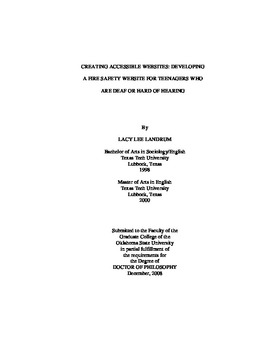| dc.contributor.advisor | Warren, Thomas | |
| dc.contributor.author | Landrum, Lacy Lee | |
| dc.date.accessioned | 2013-11-26T08:29:33Z | |
| dc.date.available | 2013-11-26T08:29:33Z | |
| dc.date.issued | 2008-12 | |
| dc.identifier.uri | https://hdl.handle.net/11244/7072 | |
| dc.description.abstract | Scope and Method of Study: This study used three research phases to create an effective fire safety website for deaf teenagers. Participants were students in grades 7-12 from the Oklahoma School for the Deaf. First, 50 students responded to a questionnaire measuring their fire safety knowledge and interests along with their internet use and preferences. For the second phase, 50 students evaluated nine of the current fire safety sites via guided worksheets, and I performed a content analysis of the same nine sites. The third phase, with a stratified selection of 20 students, involved testing the new fire safety site through think-aloud interviews, half of which were conducted via Instant Messaging software to determine whether IM is a feasible tool for usability studies. | |
| dc.description.abstract | Findings and Conclusions: Deaf teenagers have unique fire safety information needs and internet preferences. Many were unaware of specialized smoke alarms, and they wanted more information about careers for deaf people in the fire service. Of the nine sites tested, none contained information customized to helping a deaf teenager plan effectively for fire emergencies, and many of the sites violated the accessibility guidelines outlined by the World Wide Web Consortium, especially as they used audio features without captions. Six of the websites used vocabulary levels well above the recommended fourth grade reading level for deaf teenagers, and eight sites were too juvenile in tone to appeal to this audience. Echoing the design and navigation aspects of Yahoo and MySpace, the new fire safety website scored well above the other websites tested and received positive feedback from the students. An overwhelming majority of students found the site's words and pictures easy to understand and relevant to their needs, and all the students said they would recommend it to their friends. IM also proved a useful tool for usability studies because the chat transcript shows the students' natural search terms and language structure. But when using IM, researchers must be prepared to rephrase questions and to decipher responses written in text message and TTY codes. Finally, a list of recommended fire safety vocabulary is included as part of the study's conclusions. | |
| dc.format | application/pdf | |
| dc.language | en_US | |
| dc.rights | Copyright is held by the author who has granted the Oklahoma State University Library the non-exclusive right to share this material in its institutional repository. Contact Digital Library Services at lib-dls@okstate.edu or 405-744-9161 for the permission policy on the use, reproduction or distribution of this material. | |
| dc.title | Creating accessible websites: Developing a fire safety website for teenagers who are deaf or hard of hearing | |
| dc.contributor.committeeMember | Batteiger, Richard | |
| dc.contributor.committeeMember | Moder, Carol | |
| dc.contributor.committeeMember | Edwards, Steve | |
| osu.filename | Landrum_okstate_0664D_10117.pdf | |
| osu.accesstype | Open Access | |
| dc.type.genre | Dissertation | |
| dc.type.material | Text | |
| dc.subject.keywords | accessibility | |
| dc.subject.keywords | deaf | |
| dc.subject.keywords | fire safety | |
| dc.subject.keywords | technical communication | |
| dc.subject.keywords | usability | |
| dc.subject.keywords | web design | |
| thesis.degree.discipline | English | |
| thesis.degree.grantor | Oklahoma State University | |
